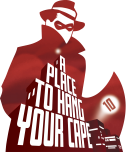Dark Beach as a title is a little bit of a misdirect. Before reading the recently released volume, I thought for sure the story would involve water and all things natural. That is not the case here; there are no beaches in Dark Beach. The world here is one with no sun and nature – it’s basically a virtual environment. This dystopia ignites speculation on “the old sun” and the world before. There are people – aptly named “sun freaks” – exploring conspiracy theories of whether the sun truly existed, reasons for why it no longer does, and continually searching for answers and meaning behind the current state of their world. Our main protagonist is Gordo; a crime photographer caught in the middle. He investigates an ongoing plot to murder members of the group, and in turn, learns about his own history.
Michael J. Ruiz-Unger’s writing is poetic. While it’s fluffy and meandering, it captures the slow and uncertain drift of thoughts from our protagonist. The over-indulgent think pieces and dialogue are more than just commentary about a world without the sun. Ruiz-Unger is especially good at drawing readers into the inner workings of his characters’ minds. He details well the turmoil they face and their perception of the world around them. Still, he doesn’t give too much away and allows for some mystery to linger. Panel layouts pair well with his style of writing. The empty spaces and full-page art spreads exhibit the high Gordo feels when he takes in the “Ghost Choker” – a particular drug in the comic. The visual impact of words separated across pages has a similar effect to how poetry uses format as a metaphor.
The comic oscillates between past and present. It encompasses scenes of Gordo’s history and “Project Daydream” – how that connects to the deaths of the sun freaks. Art style changes depending on the time period and the focus of the flashbacks. Present events have thick lines, are heavy on the use of shadows, and is very digital and modern. For the escapades of the sun freaks prior to their deaths, the art is in watercolor and abstract. As for anything to do with “Project Daydream”, it’s sketchy and grainy with lots of noise textures. Sebastian Piriz and Gonzalo Ruggieri have really good synergy when transitioning from one style to the other. The colors by Ray Jones help to tie the two art forms together.
Jones is the glue that keeps the tone of Dark Beach consistent. His work presents a dark and dystopian world, with dim colors and lingering shadows to create a sense of hopelessness. The occasional splash of red is a reminder of the ever-present danger. He uses a lot of neutrals in a dull warm filter to take away the life and vibrance of nature. However, Dark Beach’s overall aesthetic is very neon and techno. This pairs with the electric vibe and psychedelic theme of the story. At the core of this comic’s convoluted plot of old suns and mystery projects; it’s a story of a little boy just longing for the touch of his mother. The world Jones builds with his colors indicates that the lack of sun is representative of this lack of motherly warmth.
Dark Beach is excellence all around. The intrigue it has is steadily built-up by hints dropped in casual conversation. Mentions of “artificial beaches”, “may flower” and “sun clubs” are all jigsaw pieces that come together to paint the full picture. Half of the fun as the reader is being able to grab onto these pieces and put it all together yourself. Which is why I think this is much better read by issue rather than a binge read of the full volume. Although, I won’t blame you if you’re eager to know what happens next!
Want to experience a world without the sun in Dark Beach? The full collection is now available as one single volume! If this is something that interests you, it’s now available on retail stores such as Forbidden Planet and WHSmith, or even online via Amazon! Tell us on Twitter and Instagram, would you binge-read this in one sitting or let the intrigue of one issue at a time pull you in?

